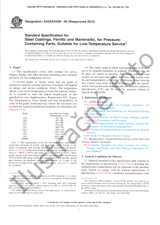Potrebujeme váš súhlas na využitie jednotlivých dát, aby sa vám okrem iného mohli ukazovať informácie týkajúce sa vašich záujmov. Súhlas udelíte kliknutím na tlačidlo „OK“.
ASTM E1561-20
Standard Practice for Analysis of Strain Gage Rosette Data
NORMA vydaná dňa 1.9.2020
Informácie o norme:
Označenie normy: ASTM E1561-20
Dátum vydania normy: 1.9.2020
Kód tovaru: NS-1008093
Počet strán: 5
Približná hmotnosť: 15 g (0.03 libier)
Krajina: Americká technická norma
Kategória: Technické normy ASTM
Kategórie - podobné normy:
Anotácia textu normy ASTM E1561-20 :
This practice defines a reference axis for each of the two principal types of rosette configurations and the equations used for three-element strain gage rosette data analysis. The primary uses of this analysis procedure are to determine the directions and magnitudes of the principal surface strains, and to determine residual stresses. This is important for consistency in reporting results and for avoiding ambiguity in data analysis, especially when computers are used. There are several possible sets of equations, but the set presented herein is perhaps the most common.
Keywords:
bending strain, Mohr´s circle of strain, rosette, shear strain, strain, strain gages, tensile strain ,, ICS Number Code 77.040.99 (Other methods of testing metals)
Doplňujúce informácie
| 1. Scope | ||||
|
1.1 The two primary uses of three-element strain gage rosettes are (a) to determine the directions and magnitudes of the principal surface strains and (b) to determine residual stresses. Residual stresses are treated in a separate ASTM standard, Test Method E837. This practice defines a reference axis for each of the two principal types of rosette configurations used and presents equations for data analysis. This is important for consistency in reporting results and for avoiding ambiguity in data analysis—especially when computers are used. There are several possible sets of equations, but the set presented here is perhaps the most common. 1.2 The equations in 4.2 and 4.3 of this practice are derived from infinitesimal (linear) strain theory. They are very accurate for the low strain levels normally encountered in the stress analysis of typical metal test objects. They become detectably inaccurate for strain levels greater than about 1 %. Rosette data reduction for larger strains is beyond the scope of this practice. 1.3 This international standard was developed in accordance with internationally recognized principles on standardization established in the Decision on Principles for the Development of International Standards, Guides and Recommendations issued by the World Trade Organization Technical Barriers to Trade (TBT) Committee. |
||||
| 2. Referenced Documents | ||||
|
Odporúčame:
Aktualizácia technických noriem
Chcete mať istotu, že používate len platné technické normy?
Ponúkame Vám riešenie, ktoré Vám zaistí mesačný prehľad o aktuálnosti noriem, ktoré používate.
Chcete vedieť viac informácií ? Pozrite sa na túto stránku.




 Cookies
Cookies
